JICA President Shinichi Kitaoka visited Ethiopia and Kenya from Nov. 25 to Dec. 1, in his first overseas trip since assuming office, and announced JICA's intention to strengthen partnerships in advance of the Tokyo International Conference on African Development (TICAD) VI in 2016.
Ethiopia is home to the head office of the African Union Commission (AUC), which is one of the co-organizers of TICAD VI. And Kenya has been chosen as the host country of TICAD VI next year. It will be the first TICAD meeting to be held on the African continent.
While in the two countries, Mr. Kitaoka held talks with such dignitaries as Chairperson of AUC Nkosazana Clarice Dlamini Zuma, Ethiopian Prime Minister Hailemariam Desalegn and Kenyan Deputy President William Arap Ruto. Furthermore, he visited JICA project sites in both countries.
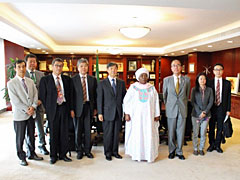
Ambassador Extraordinary and Plenipotentiary of Japan to Ethiopia Kazuhiro Suzuki, third from right, and JICA President Shinichi Kitaoka pay a courtesy visit to AUC Chairperson Nkosazana Clarice Dlamini Zuma, center. Also pictured is the Japanese team that provides guidance on KAIZEN at AU headquarters.
During this visit, Mr. Kitaoka reconfirmed the expectations and trust African leaders place in Japan. He said that in its cooperation with Africa, JICA will carry out projects that align with Japan's Development Cooperation Charter, the Sustainable Development Goals (SDGs) and Agenda 2063, which the African Union (AU) formulated as a long-term vision for Africa. He added that it is important to implement the projects while engaging in a dialogue based on a relationship of mutual trust, ownership and partnership. He also expressed the view that it is necessary to encourage economic growth and to provide inclusive support that does not to leave the most vulnerable members of society behind.
1. Ethiopia visit
On Nov. 26, Mr. Kitaoka met with Ms. Zuma and discussed topics including human resource development, industrial development and trade for the socioeconomic development of Africa.
On Nov. 25, he met with Mr. Hailemariam. Mr. Hailemariam expressed his high opinion of wide-ranging past cooperation from JICA and his trust of Japan, along with his strong expectations in particular for dialogue on industrial policy, for the KAIZEN movement and for geothermal energy development.
Mr. Kitaoka said Japan and Ethiopia have much in common and that JICA would like to continue to contribute to the socioeconomic development of Ethiopia through cooperation that makes use of Japan's experience.
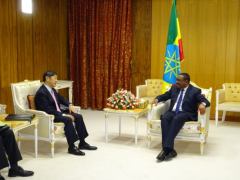
From left, JICA President Shinichi Kitaoka and Ethiopian Prime Minister Hailemariam Desalegn
Mr. Kitaoka visited the sites of JICA projects during his stay in Ethiopia. He visited the Ethiopian KAIZEN Institute, which is the executing agency for the “Project on Capacity Development for KAIZEN Implementation,” conferred a JICA President's Award 2015 and expressed his high hopes for the KAIZEN (a method of bottom-up continuous improvement in productivity and quality developed by Japanese industry and made famous by Toyota) movement, which he called a model not just for Ethiopia but for all of Africa.
He also visited a shoe manufacturer that is practicing KAIZEN and saw for himself the way the KAIZEN movement is taking root in Ethiopia.
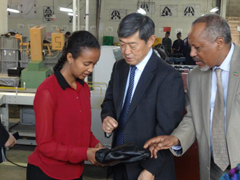
JICA President Shinichi Kitaoka listens to an explanation from Ethiopian KAIZEN Institute General Director Getahun Tadesse at a shoe manufacturer that practices KAIZEN.
He visited a location where Japanese experts are transferring mapmaking techniques to their Ethiopian counterparts as part of the “Capacity Development Project for National Spatial Data Infrastructure.” There, he confirmed the usefulness and importance of technical cooperation in the field. Mr. Kitaoka also observed a Japan Overseas Cooperation Volunteer in charge of cultivating aesthetic sensitivity in second-graders at an elementary school in Addis Ababa. The volunteer was energetically teaching a class with an Ethiopian fellow teacher, speaking the local language fluently.
2. Kenya visit
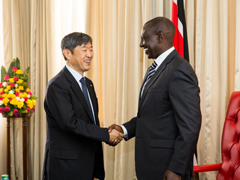
From left, JICA President Shinichi Kitaoka and Kenyan Deputy President William Arap Ruto
Mr. Kitaoka met with Kenyan Deputy President William Arap Ruto on Nov. 30. Mr. Kitaoka talked about having visited Mombasa Port the previous day, and he mentioned that since supporting the expansion of Mombasa International Airport in the 1970s, Japan has been paying special attention to the region. He noted that the port is a gateway to the East African region, and comprehensive development is significant not just for Kenya but also for surrounding countries. In order to attain such development, JICA would like to carry out well-thought-out cooperation that takes into consideration both the environment and society through dialogue with Kenyan stakeholders.
Mr. Ruto expressed great appreciation on behalf of the Kenyan government for Japan's continuous support for infrastructure development in Mombasa and elsewhere, for support in the energy sector including the Olkaria Geothermal Power Plant, as well as in the agriculture, education and health sectors. He said he hopes the two countries can deepen their stable relationship and expressed determination to make TICAD VI a success next year.
During his visit to Mombasa Port, Mr. Kitaoka received an explanation from the Kenya Ports Authority and Japanese stakeholders of a new container terminal soon to be completed with the help of Japanese ODA loans. He also visited a container berth constructed using the landfill method of soft ground, which is a Japanese technology, and saw a Japanese-made gantry crane with an environmentally friendly hybrid engine. Furthermore, Mr. Kitaoka listened to an explanation to the effect that through these projects, Kenyans engaged in the construction work improved their abilities and technical skills. In response, Mr. Kitaoka said this initiative is a good example of Japanese-style cooperation, and that such cooperation that is truly useful for local people should be carried out in the upcoming port expansion project as well.
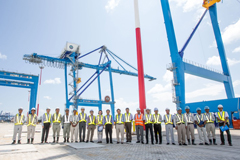
Visit to a Mombasa Port container terminal that uses a Japanese-made gantry crane to unload containers from ships
On Dec. 1, the last day of his visit to Kenya, Mr. Kitaoka visited Jomo Kenyatta University of Agriculture and Technology (JKUAT). JKUAT is a national university to which Japan has provided grant aid and technical cooperation since the 1970s. In Kenya, it has achieved the firm status of a high-level educational institute involved in practical science, and many people show interest in studying there. As a part of the Pan African University network being developed by the AU, JKUAT is contributing to improving education for African region, including the establishment of graduate school programs with such themes as science, technology and innovation.
Mr. Kitaoka emphasized the important role university and tertiary education plays. He said human resource development is a task that requires a long, sustained effort, but JKUAT has become an independent university after long years of cooperation and has recently engaged in joint ventures with private Japanese companies. He called it a good example of how cooperation with Japan has born solid results.




scroll